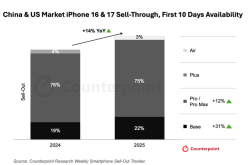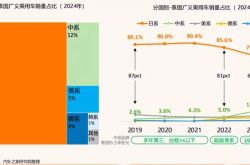From "Dark Horse" to "Marginalized Player": The Decline of JD Cloud in the Cloud Computing Arena
![]() 05/19 2025
05/19 2025
![]() 701
701
In today's rapidly evolving digital economy, cloud computing stands as the "water, electricity, and coal" fueling global industrial transformation. From the adoption of government clouds to enterprise digital transformations, and from the surge in AI computing power to the rise of edge computing, the cloud services landscape has long been ablaze with competition. Amidst this technological revolution, Alibaba Cloud, Tencent Cloud, and Huawei Cloud collectively hold nearly 70% of the market share, while JD Cloud emerged as a promising "dark horse." However, despite retaining the aura of "JD Group's technological core," JD Cloud's internal turmoil is evident: excessive reliance on group funding, insufficient investment in technology R&D, and the struggle to break out of its closed ecological loop have left it trapped within the confines of the "retail cloud" label, facing a dilemma.

This crisis is not a fluke. In 2024, the global cloud services market surpassed $1.2 trillion, with the Matthew Effect becoming increasingly pronounced; the top five vendors captured 76% of the market share, leaving little room for smaller players. JD Cloud's predicament mirrors the collective anxiety of second-tier cloud providers squeezed by capital, technology, and ecosystem challenges: grow big or perish; differentiate or fade away.
Yet, is JD Cloud truly resigned to being a runner-up? At a recent strategic conference, JD Cloud made a bold move, announcing an "All-in AI" strategy, committing 50 billion yuan to bolster intelligent computing power and unveiling its self-developed large model, "Yanxi 2.0." Is this seemingly desperate gamble a call for a counterattack or merely a helpless response to capital pressures?
Red Ocean Battle in Cloud Services
JD Cloud's rise was inextricably linked to its parent company's retail DNA. Leveraging the group's e-commerce scenarios, JD Cloud swiftly gained a foothold with "retail cloud" as its entry point, taking the lead in supply chain management and warehouse logistics digitization. By 2020, its revenue exceeded 10 billion yuan, growing at a rate of 67%, earning it the status of an industry "dark horse."
However, what propelled its success also contributed to its downfall. On one hand, an excessive dependence on the JD ecosystem. Being too tethered to retail business confined JD Cloud within the "single scenario" trap. In 2023, JD Group accounted for 72% of JD Cloud's revenue, with external customers comprising less than 30%. In contrast, over 80% of Alibaba Cloud's revenue comes from non-Alibaba customers, and Huawei Cloud holds a 45% share in the government and enterprise markets. On the other hand, cross-industry cooperation remains weak. While Huawei Cloud has strategic partnerships with 38 provincial governments and Tencent Cloud boasts top customers like NIO and XPeng in the automotive industry, JD Cloud has few notable cases beyond a handful of logistics collaborations, making it challenging to attract high-end clients.
This dependence was starkly exposed by the shifting industry landscape. As global retail growth decelerated, JD Group's revenue growth rate plummeted from 29% to 11% in 2024, directly hindering JD Cloud's expansion. More critically, its prized "retail solutions" are being replicated by competitors—Alibaba Cloud introduced "Retail Brain," Tencent Cloud integrates offline scenarios with WeChat Enterprise, and Huawei Cloud leverages the HarmonyOS ecosystem in smart stores. As its differentiated advantages diminish, JD Cloud's technological moat is crumbling.
Dilemma Under Internal and External Pressures
Competition in China's cloud computing market has transcended the initial "resource stacking" phase, evolving into a comprehensive squeeze on technology ecosystems and globalization capabilities. Leading vendors, leveraging their technological hegemony, continue to raise industry barriers, from self-developed chips and AI large models to full-stack solutions, each layer of technological hurdles compressing the survival space for latecomers.
First, external pressure: double squeeze from technology ecosystems and price wars
Leading vendors are constructing barriers through "technology bundling." Alibaba Cloud leverages the AI capabilities of the Damo Academy, Tencent Cloud taps into the WeChat ecosystem, and Huawei Cloud boasts a full-stack advantage of "cloud + 5G + chips," continuously raising the bar. In contrast, JD Cloud's technological identity is blurred, lacking both self-developed chips (like Aliyun Yitian 710) and leading AI large models (like Tencent Yuanhen), and even in key PaaS layer areas such as container services and Serverless, it relies on secondary packaging of open-source frameworks.
Second, internal wounds: superficial R&D investment and failed ecological collaboration
JD Cloud has long touted "R&D investment exceeding 15%" as a selling point, but the 2024 financial report revealed a harsh reality: 60% of R&D expenses are allocated to maintaining existing products and customizing customer needs, with only 20% invested in cutting-edge areas like AI and edge computing. A former technical executive disclosed: "Internal assessments prioritize short-term deliverables, overlooking long-term technological accumulation, leading to significant R&D resources being spent on 'patchwork.'" More critically, due to compliance requirements, the financial sector favors more privatized deployments, turning JD Cloud's once-vaunted "domestic demand feedback" model into a shackle binding its marketization potential.
Third, industry barriers: the "shoal dilemma" of solutions
In the government and enterprise markets, customers seek solutions deeply integrated with their business, rather than standardized cloud resources. Although JD Cloud has proposed vertical products like "retail cloud," "logistics cloud," and "financial cloud," in actual delivery, it primarily sells IaaS layer resources. A bidding document for a provincial government cloud project revealed that JD Cloud was directly disqualified due to "lack of a localized operation and maintenance team" and "imperfect data security solutions." Low customer stickiness and high replacement costs have become insurmountable ceilings.
JD Cloud's Desperate Counterattack
JD Cloud's desperate counterattack appears as a declaration of strategic awakening but, in reality, exposes its long-term path dependence and strategic anxiety. If these strategies remain slogans, they are mere self-comfort for a declining entity; however, if they can genuinely address the core issues and heal the wounds, there may be a glimmer of hope. Yet, the vast gap between top-level design and implementation dooms this "desperate counterattack" to be fraught with challenges and uncertainty.

The so-called "contraction of battle lines and return to retail" is essentially a correction of blind expansion but may also plunge into another strategic illusion. Focusing on the retail track seems a rational choice to leverage ecological advantages, but retail digitization competition is fierce: Alibaba Cloud relies on Tmall and Taobao's massive transaction data, Tencent Cloud holds the WeChat ecosystem's traffic password, and if JD Cloud relies solely on micro-innovations like "supply chain forecasting" and "dynamic pricing," it falls short of building a robust technological moat.
More perilously, excessive contraction could diminish its presence in incremental markets like government and manufacturing, ultimately reducing it to an "internal IT service provider" for JD Group. Whether this "strategic retreat" is a bold move or slow suicide hinges on whether it can truly distill non-replicable underlying capabilities from retail scenarios, rather than continuing to peddle pseudo-solutions in the guise of "data interfaces."
The notion of "value wars replacing price wars" reveals JD Cloud's misjudgment of industry competition's essence. When customers pay for results, cloud vendors must have absolute control over converting technological capabilities into business increments, an area where JD Cloud falters. As leading vendors incorporate "pay-for-performance" into their service systems, JD Cloud's "innovation" strategy lacks uniqueness and may even exacerbate customer trust issues due to technological shortcomings. As the industry shifts from "resource pricing" to "value density," the survival space for second-tier vendors will only shrink further.
Ultimately, as industry competition intensifies into an "ecological war," the comparison is no longer about single-point technology or price but rather full-chain dominance, encompassing chips, algorithms, and scenario implementation. The outcome of this battle may already be decided by capital and technology scales. As global cloud giants reshape industry rules with tens of billions of dollars, JD Cloud's "50 billion yuan gamble" appears more like a tragic charge. It must either break free and transform or become a footnote of the times—with no middle ground.
Industry shuffling never ceases. Snowflake revolutionized the game with its cloud-native database, ByteDance reconstructed edge clouds with short video computing power, and even Pinduoduo is deploying vertical clouds for agriculture. These cases prove that differentiated breakthroughs are the sole lifeline for smaller players. However, JD Cloud's "AI gamble" has yet to chart a clear path: of the 50 billion yuan investment, how much is dedicated to underlying computing power? How much to ecological construction? And how much can be converted into real revenue? As competitors' AI large models bear fruit in medical, manufacturing, and scientific research fields, JD Cloud's "Yanxi" remains stuck in customer service scripts, conversing with itself.
The ultimate outcome of cloud services may not be "winner-takes-all," but it will undoubtedly be "survival of the fittest." If JD Cloud aims to avoid becoming a "footnote of the times," it must sever its closed loop with the pain of self-disruption and reshape its ecosystem with the courage to break boundaries. Otherwise, when the next technological wave hits, its name will only appear in the "Others" column of industry report footnotes—silent and unnoticed.








